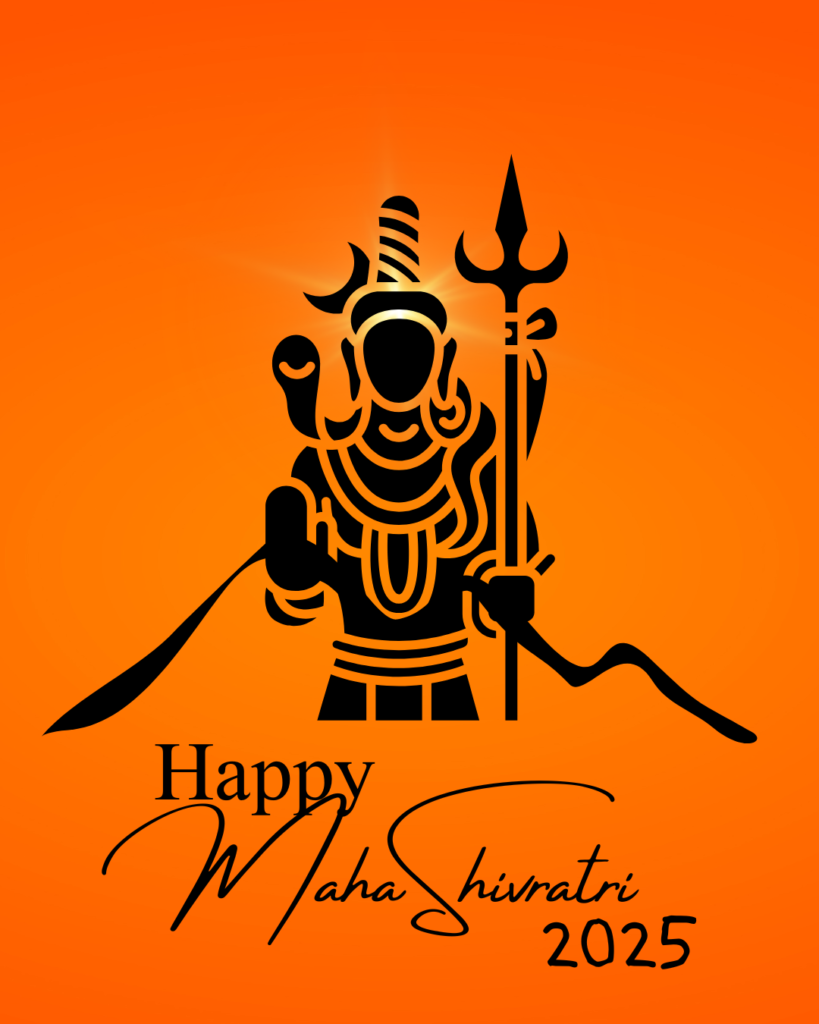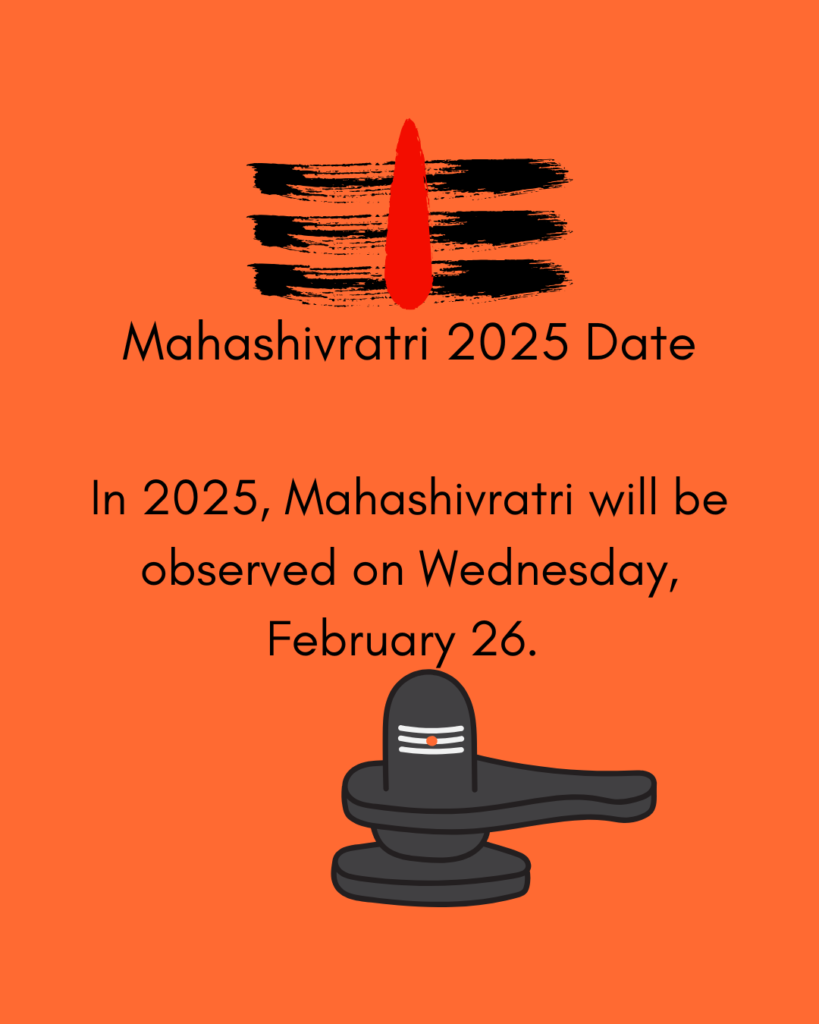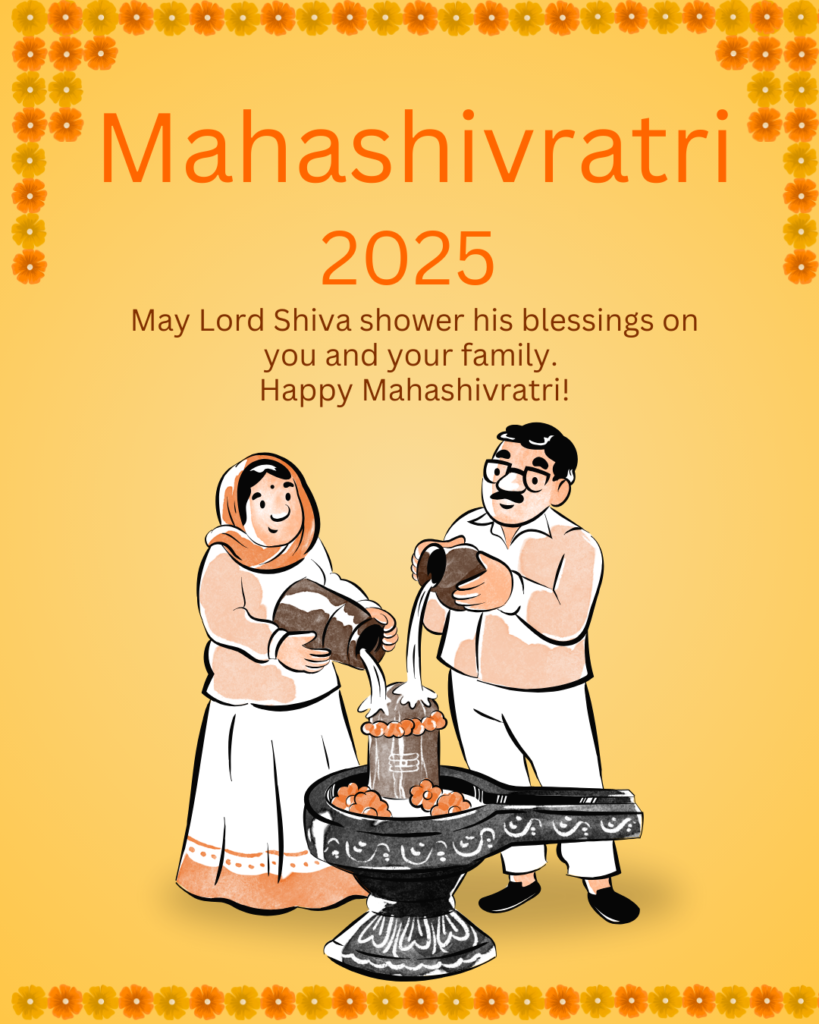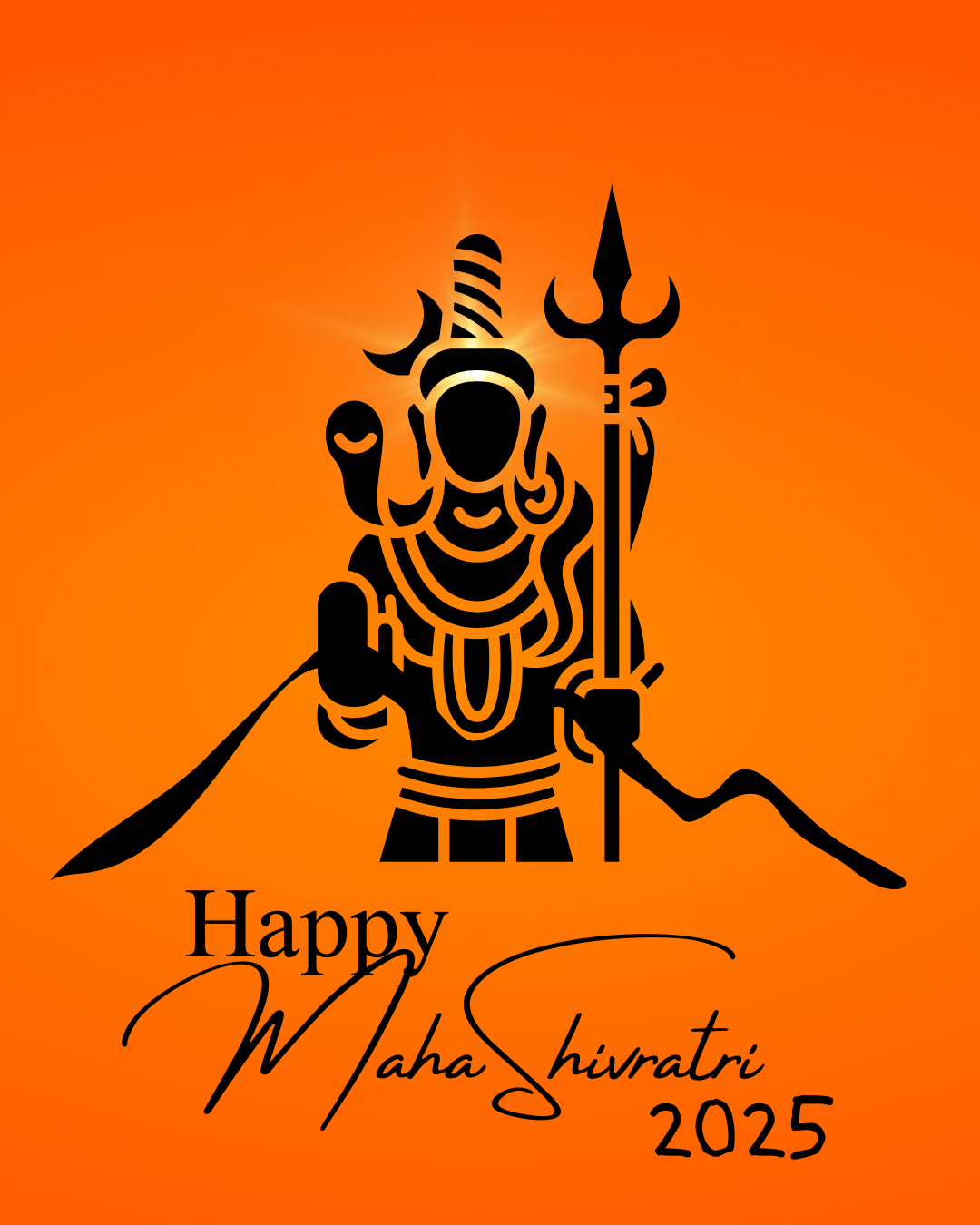Mahashivratri 2025: Date, Puja Time, Vidhi. Celebrate Mahashivratri 2025 with devotion! Find the date, puja timings, vrat vidhi, rituals, significance, puja samagri list, and fasting rules. Discover Shivratri wishes, quotes, and messages to share with loved ones. Stay updated with the correct Mahashivratri 2025 date and time in India. Har Har Mahadev!

Mahashivratri 2025: Date, Puja Time, Vidhi
Mahashivratri, known as the “Great Night of Lord Shiva,” is a significant Hindu festival dedicated to Lord Shiva. In 2025, Mahashivratri will be observed on Wednesday, February 26. This auspicious day is marked by devotees engaging in various rituals, fasting, and night-long vigils to honor and seek the blessings of Lord Shiva.
Mahashivratri 2025 Date
In 2025, Mahashivratri will be observed on Wednesday, February 26.

Date and Puja Timings in India
According to the Drik Panchang, the detailed schedule for Mahashivratri 2025 is as follows:
- Chaturdashi Tithi Begins: 11:08 AM on February 26, 2025
- Chaturdashi Tithi Ends: 08:54 AM on February 27, 2025
- Nishita Kaal Puja Time: 12:09 AM to 12:59 AM on February 27, 2025
- Ratri First Prahar Puja Time: 6:19 PM to 9:26 PM on February 26, 2025
- Ratri Second Prahar Puja Time: 9:26 PM on February 26 to 12:34 AM on February 27, 2025
- Ratri Third Prahar Puja Time: 12:34 AM to 3:41 AM on February 27, 2025
- Ratri Fourth Prahar Puja Time: 3:41 AM to 6:48 AM on February 27, 2025
- Shivaratri Parana Time: 6:48 AM to 8:54 AM on February 27, 2025
These timings are crucial for devotees to perform rituals at the most auspicious moments.
Significance of Mahashivratri
Mahashivratri holds profound spiritual importance for devotees of Lord Shiva. It is believed to be the night when Lord Shiva performed the cosmic dance, Tandava, symbolizing creation, preservation, and destruction. Additionally, many believe it marks the divine marriage of Lord Shiva and Goddess Parvati. Observing this festival is thought to absolve past sins and lead devotees towards moksha (liberation).
Puja Vidhi (Worship Rituals)
Performing the Mahashivratri puja with devotion is essential. Here’s a step-by-step guide:
- Morning Preparations:
- Bathing: Begin the day with a bath, preferably using water mixed with sesame seeds to purify the body and soul.
- Attire: Wear clean, preferably white or saffron-colored clothes.
- Sankalp (Vow):
- Take a pledge to observe a full-day fast and seek Lord Shiva’s blessings for strength and determination.
- Evening Puja:
- Second Bath: Before the evening puja, take another bath to cleanse oneself.
- Shiva Linga Abhishekam: Offer a ritualistic bath to the Shiva Linga with substances like milk, honey, yogurt, ghee, sugar, and water, each symbolizing different blessings.
- Offerings: Present Bilva (Bel) leaves, fruits, incense, and lamps to the deity.
- Mantra Chanting: Recite “Om Namah Shivaya” and other Shiva mantras.
- Aarti: Conclude the puja with the Shiva Aarti, singing hymns in praise of Lord Shiva.
- Night Vigil (Jagaran):
- Stay awake throughout the night, chanting prayers, singing bhajans, and meditating on Lord Shiva.
- Breaking the Fast (Parana):
- The fast is typically broken the next morning after bathing and offering prayers during the Parana time.
Adhering to these rituals with sincerity is believed to invoke Lord Shiva’s grace and blessings.
Symbolism Behind Maha Shivaratri Rituals
Mahashivratri is not just a festival but a deeply spiritual occasion that carries profound symbolism:
- Fasting (Vrat):
- Represents self-discipline and control over desires.
- Helps cleanse the body and mind, leading to spiritual enlightenment.
- Night Vigil (Jagran):
- Symbolizes the conquest of darkness (ignorance) with light (wisdom).
- Staying awake signifies awareness and devotion to Lord Shiva.
- Shiva Linga Abhishekam (Ritual Bathing):
- Water: Purifies the soul.
- Milk: Represents purity and kindness.
- Honey: Signifies sweetness in speech and deeds.
- Yogurt: Stands for prosperity.
- Ghee: Symbolizes victory and knowledge.
- Sugar: Represents happiness.
- Bilva (Bel) Leaves: Shows devotion and surrender to Shiva.
- Chanting “Om Namah Shivaya”:
- Enhances spiritual vibrations and invokes divine energy.
- Offering Datura and Bhang:
- These items are believed to be favorites of Lord Shiva and symbolize the detoxification of negativity.
Maha Shivaratri Rituals and Traditions
Mahashivratri is observed with great devotion through these key traditions:
1. Early Morning Rituals
- Devotees wake up before sunrise and take a holy bath, preferably in a sacred river.
- Clean and wear fresh clothes (white or saffron preferred).
- Visit a Shiva temple or perform puja at home.
2. Observing Fast (Vrat)
- Devotees observe either Nirjala Vrat (without food and water) or Phalahar Vrat (fruits, milk, and vrat-friendly food).
3. Shiva Linga Abhishekam
Performing Abhishekam with:
✔ Water, Milk, and Honey – For purification.
✔ Ghee, Yogurt, and Sugar – For prosperity.
✔ Sandalwood Paste and Bhasma – For wisdom and devotion.
4. Performing Aarti and Chanting Mantras
- Recite the Maha Mrityunjaya Mantra and Om Namah Shivaya.
- Sing Shiva Aarti to conclude the puja.
5. Night Vigil (Jagran)
- Devotees stay awake, meditating and singing Shiva bhajans.
- This symbolizes breaking the cycle of ignorance and attaining self-realization.
Devotees Can Offer These Items to Please Lord Shiva on Maha Shivratri 2025
To seek Lord Shiva’s blessings, devotees should offer the following:
✅ Bilva (Bel) Leaves – Symbol of devotion.
✅ Milk & Water – Purity and peace.
✅ Honey & Sugar – Sweetness in life.
✅ Bhasma (Ash) – Renunciation of worldly attachments.
✅ Bhang & Datura – Symbolic offerings that detoxify negativity.
✅ Fruits & Dry Fruits – Health and prosperity.
✅ Sandalwood Paste – Cooling effect and purity.
✅ Incense & Diya (Oil Lamp) – Illumination and divine blessings.
Shivratri 2025 Puja Samagri List
To perform a proper Mahashivratri puja, you will need:
📌 Puja Items:
- Shiva Linga or Image of Lord Shiva
- Panchamrit (Milk, Yogurt, Honey, Ghee, Sugar)
- Bilva (Bel) Leaves
- Datura and Bhang
- Gangajal (Holy Water)
- Sandalwood Paste
- Rice and Akshat (Unbroken Rice Grains)
- Diya (Oil Lamp)
- Incense Sticks and Camphor
- Flowers (Lotus, Dhatura, etc.)
- Fruits and Dry Fruits
- Prasad (Kheer, Panchamrit, or Fruits)
- New Clothes for the Idol
Happy Mahashivratri Wishes, Quotes, and Messages in English

💙 Mahashivratri Wishes:
- 🙏 May Lord Shiva shower his blessings on you and your family. Happy Mahashivratri!
- 🔱 Om Namah Shivaya! May all your wishes come true on this auspicious night.
- 🌿 Wishing you peace, prosperity, and divine blessings on this Mahashivratri!
💬 Mahashivratri Quotes:
- “Shiva is not just a deity, he is a cosmic truth.” – Sadhguru
- “The power of Lord Shiva destroys all evil and brings peace.”
- “Adiyogi is the source of yoga, and Mahashivratri is the night of transformation.”
📩 Mahashivratri Messages:
- On this holy night, let’s chant ‘Om Namah Shivaya’ and seek Lord Shiva’s divine blessings!
- May this Mahashivratri bring happiness, prosperity, and the strength to overcome all obstacles.
- Har Har Mahadev! May Lord Shiva remove all your sufferings and bless you with joy and peace.
Final Thoughts
Mahashivratri 2025 is a powerful occasion to connect with the divine energy of Lord Shiva. By following the right rituals, offering prayers with devotion, and observing a fast with sincerity, devotees can seek spiritual growth and divine blessings.
🔱 Om Namah Shivaya! Wishing you a blessed and peaceful Mahashivratri! 🔱
Q1: When is Mahashivratri 2025?
A1: Mahashivratri 2025 will be observed on Wednesday, February 26.
Q2: What is the significance of Mahashivratri?
A2: It commemorates Lord Shiva’s cosmic dance (Tandava) and his divine marriage to Goddess Parvati, symbolizing the union of masculine and feminine energies.
Q3: What should we do on Mahashivratri to get Lord Shiva’s blessings?
A3: To seek Lord Shiva’s blessings on Mahashivratri, devotees should:
Observe a fast with full devotion.
Wake up early, take a holy bath, and wear clean clothes.
Visit a Shiva temple and perform Rudrabhishekam by offering milk, honey, ghee, curd, sugar, and water to the Shiva Linga.
Offer Bilva (Bel) leaves, as they are believed to be Lord Shiva’s favorite.
Chant “Om Namah Shivaya” and recite the Shiva Purana.
Perform Shivratri Aarti and meditate for spiritual upliftment.
Stay awake all night (Jagaran) and engage in bhajans and kirtans.
Perform charitable acts like feeding the poor and offering donations.
Q4: Why do we celebrate Mahashivratri?
A4: Mahashivratri is celebrated to honor Lord Shiva. It is believed that on this night, he performed the cosmic dance (Tandava), signifying the cycle of creation, preservation, and destruction. Another belief is that this is the night when Lord Shiva married Goddess Parvati.
Q5: What are the benefits of observing a fast on Mahashivratri?
A5: Fasting on Mahashivratri is believed to:
Purify the body and mind.
Help in self-discipline and self-control.
Remove past sins and negative karma.
Bring spiritual enlightenment and inner peace.
Strengthen devotion to Lord Shiva.
Q6: Can we drink water during Mahashivratri fasting?
A6: Yes, devotees observing a partial fast (Phalahar Vrat) can drink water and consume fruits, milk, and other vrat-friendly foods. However, those observing a Nirjala Vrat abstain from food and water completely.
Q7: What are the do’s and don’ts during Mahashivratri?
A7:
✔ Do’s:
Observe fast with dedication.
Chant “Om Namah Shivaya” and read Shiva Purana.
Perform Rudrabhishekam and offer Bilva leaves.
Stay awake and engage in prayers and bhajans.
✖ Don’ts:
Avoid consuming grains, alcohol, and non-vegetarian food.
Do not speak ill of others or engage in negative thoughts.
Avoid oversleeping; instead, spend time in devotion.
Q8: Can pregnant women observe Mahashivratri fast?
A8: Yes, but only under medical guidance. Pregnant women can follow a modified fast by consuming fruits, milk, and vrat-friendly food to ensure their health and well-being.
Q9: Can children observe the Mahashivratri fast?
A9: Fasting is optional for children. If they wish to participate, they can follow a light fast by eating fruits, milk, and vrat-approved foods.
Q10: What is the spiritual significance of staying awake (Jagaran) on Mahashivratri?
A10: Staying awake all night is symbolic of overcoming ignorance and darkness with wisdom and devotion. Devotees engage in meditation, bhajans, and chanting to elevate spiritual consciousness.
Q11: What are the special temples to visit on Mahashivratri?
A11: Some of the most revered Shiva temples to visit during Mahashivratri include:
Kashi Vishwanath Temple (Varanasi)
Somnath Temple (Gujarat)
Kedarnath Temple (Uttarakhand)
Mahakaleshwar Temple (Ujjain)
Amarnath Cave Temple (Jammu & Kashmir)
Q12: Can I eat salt during Mahashivratri fast?
A12: Regular table salt is avoided. However, sendha namak (rock salt) is allowed in vrat-friendly food.
Q13: What is the importance of Bilva (Bel) leaves in Mahashivratri puja?
A13: Bilva leaves are considered sacred and dear to Lord Shiva. Offering them is believed to bring peace, prosperity, and the removal of past sins.
Q14: Can non-Hindus participate in Mahashivratri celebrations?
A14: Yes, anyone who wishes to seek spiritual enlightenment and divine blessings can participate in Mahashivratri celebrations.
Q15: How is Mahashivratri celebrated in different states of India?
A15:
North India: Devotees visit temples, perform Rudrabhishekam, and observe fasting.
South India: Special pujas are conducted in temples like Chidambaram and Rameshwaram.
West India: Celebrations in Gujarat and Maharashtra include night-long kirtans and bhajans.
East India: Special fairs and processions are held, especially in Odisha and Bengal.
Related article: https://stationvidya.com/20-thought-of-the-day-for-kids/
You can follow us on Instagram: https://www.instagram.com/stationvidya/
Facebook: https://www.facebook.com/stationvidya/
You tube: https://www.youtube.com/@stationvidya/
We hope you’d loved the content , please do like, share and comment.
Subscribe for notification

Leave a Reply to Hexagram symbol Cancel reply